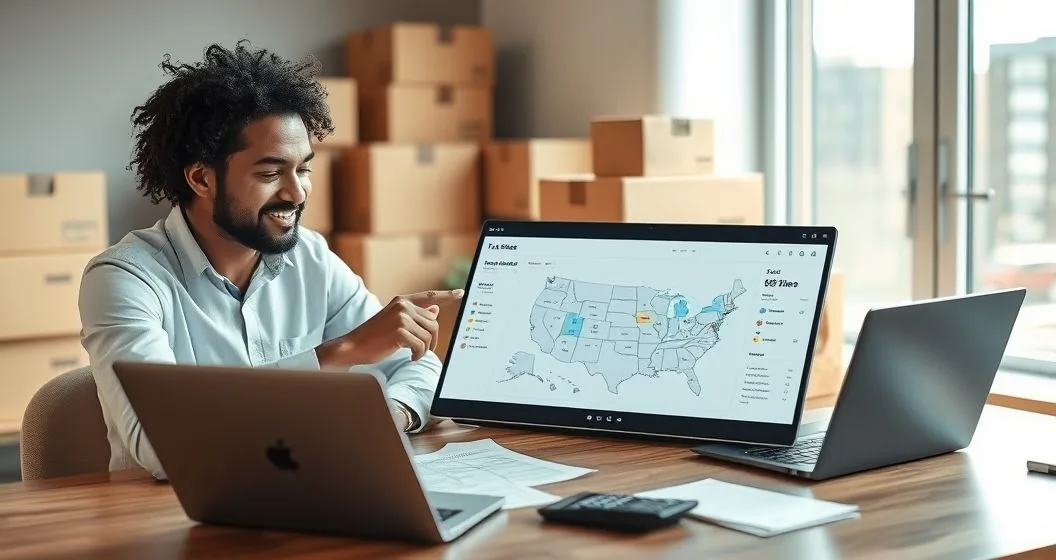Background and why it matters
The 2018 Supreme Court decision in South Dakota v. Wayfair changed the rules for remote sellers by allowing states to require sales tax collection based on economic nexus instead of physical presence (South Dakota v. Wayfair, Inc., 2018). After Wayfair, many states adopted economic thresholds or marketplace-facilitator laws that increase where online sellers have obligations. For up-to-date guidance, always check the state Department of Revenue for each state where you sell.
How nexus is commonly established
- Physical nexus: a business location, employees, inventory stored in a third-party warehouse (including some fulfillment‑by‑merchant and third‑party logistics arrangements), trade shows, or a sales rep in the state.
- Economic nexus: reaching a state’s sales or transaction threshold (states set their own thresholds and these change over time).
- Marketplace facilitator rules: many states require platforms (Amazon, Etsy, eBay) to collect and remit tax on behalf of sellers for marketplace sales. This can reduce — but not always eliminate — a seller’s registration needs.
In-practice note
In my work with online retailers, the most common compliance gap is failing to track sales by state in real time. A client who used multiple fulfillment centers did not realize inventory in a third state created physical nexus until they received a notice. Addressing that required retroactive registration, payment plans, and amended returns — all avoidable with proactive tracking.
Step-by-step compliance checklist
- Map your activities. Track where you store inventory, have employees, or attend events. Include third‑party warehouses (FBA/3PL).
- Monitor state thresholds. Use a rolling 12‑month view for sales and transaction counts and confirm each state’s current rule with its DOR website.
- Register promptly. If you hit a nexus trigger, register for a sales tax permit with that state’s DOR and begin collecting tax as required.
- Decide who collects. Determine whether the marketplace or you are responsible for collection — check marketplace facilitator rules for each state.
- Collect, remit and file. Apply the correct state and local rates, remit collections on schedule, and file periodic returns. Local rates/counties can differ within a state.
- Keep records. Maintain sales, exemption certificates, and filing records for at least several years (state retention rules vary).
- Use automation. Tax engines reduce errors and simplify filings across jurisdictions.
Practical tools and costs
Tax automation services (TaxJar, Avalara, Sovos and others) can calculate rates, create returns and sometimes file directly with states — they are worth evaluating against the cost of manual compliance and the risk of audits. Marketplace sellers should confirm what the marketplace reports and retains for their records.
Common mistakes and how to avoid them
- Assuming only physical presence matters: after Wayfair most states use economic tests.
- Ignoring marketplace rules: sellers can overlook that marketplaces collect tax but still require seller registration for reporting.
- Poor recordkeeping: missing exemption certificates or sales breakdowns can lead to denied refund claims and penalties.
- Using outdated thresholds: state rules change; confirm thresholds directly with the state DOR.
Where to confirm rules and authoritative sources
- South Dakota v. Wayfair, Inc., Supreme Court (2018): https://www.supremecourt.gov/opinions/17pdf/17-494_j4el.pdf
- IRS — Sales and use tax basics (state taxes): https://www.irs.gov/businesses/small-businesses-self-employed/sales-and-use-tax
- State Departments of Revenue: search the specific state DOR for current thresholds and filings.
Related resources on FinHelp.io
- Nexus Basics for Service-Based and Digital Businesses — https://finhelp.io/glossary/nexus-basics-for-service-based-and-digital-businesses/
- Sales Tax Collection Best Practices for Online Sellers — https://finhelp.io/glossary/sales-tax-collection-best-practices-for-online-sellers/
Final tips and professional disclaimer
Start monitoring state sales by customer location from day one and keep a rolling 12‑month tally for economic nexus. When in doubt, register and consult a tax advisor — registration and voluntary disclosure programs are often less costly than an audit. This article is educational and not a substitute for personalized tax advice; consult a licensed tax professional for decisions specific to your business.



